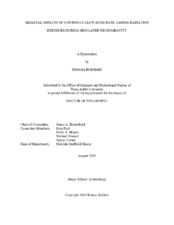| dc.description.abstract | One of the greatest unknowns in human spaceflight is the effects of low-dose-rate
galactic cosmic radiation (GCR). The majority of radiation studies deliver the total radiation dose
expected on a 2-3 year mission in minutes. However, timing of radiation delivery is known to be
biologically relevant. Very few studies have attempted to assess an appropriate timing, or doserate,
of GCR exposure.
We tested the effects of continuous low-dose-rate radiation (CIRR, dose rate of 6.25
mGy/day for 28 days) in combination with a slightly interrupted hindlimb unloading (iHU),
simulated microgravity, and exercise treatments. CIRR alone led to few changes compared to the
non-irradiated group. CIRR+iHU led to reductions in total body bone mineral density, lean mass,
fat mass, cancellous bone volume and microarchitecture, and femoral neck ultimate load.
Although exercise led to improvements in bone mass it was not able to mitigate losses when
combined with CIRR and iHU. This indicates a differential response of bone to CIRR in
combination with iHU. CIRR may not be detrimental to bone alone but further study is needed to
understand the negative effects during iHU, which may not be rescuable by exercise.
In the second experiment, we sought to assess how aging may affect the response to
CIRR and HU in adult and middle-aged (astronaut aged) mice. Astronaut aged animals
responded differently to CIRR and HU alone compared to adult animals. CIRR+HU diminished
bone parameters beyond HU alone in both ages. Finally we conclude that young, skeletally
mature animals may not be a good model for middle-aged crew members.
Our results show that CIRR alone is not detrimental to bone, unlike what is normally
found with acute radiation. Care on future missions should be taken to counter the combined
detrimental effect of CIRR and unloading on bone. Our findings in different ages of mice suggest
that the response to the combination of unloading and CIRR is conserved regardless of age and is
therefore a continued life-long concern. The effects of space relevant radiation on bone continue
to be a concern for future spaceflight missions, especially exploration class missions to the moon
and Mars. | en |


